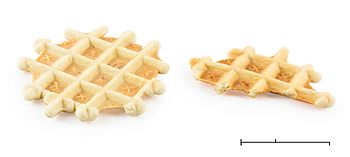Kue gapit facts for kids

Whole (left) and partial kue gapit; scale bar shows 1 cm / 1″
|
|
| Type | Snack (Kue) |
|---|---|
| Place of origin | Indonesia |
| Region or state | Cirebon, West Java |
| Main ingredients |
|
Kue gapit is a yummy dry snack from Indonesia, specifically from a place called Cirebon in West Java. It's usually made from tapioca flour. Its name comes from how it's cooked: it's grilled between special iron molds, just like making a waffle!
You can find Kue gapit in many shapes and flavors. Even though it's a popular souvenir for people visiting Cirebon, local residents don't eat it very often.
Contents
How Kue Gapit is Made
Making Kue gapit involves a few simple steps. One way to make it uses wheat flour, rice flour, chicken eggs, coconut water, salt, sugar, and cinnamon.
First, the eggs are beaten. Then, cinnamon and sugar are mixed in. After these ingredients are well blended, flour and salt are added. This mixture is stirred even more.
Next, coconut water is added to the mix. A spoonful of this batter is placed between hot iron molds. It's then grilled until it's perfectly cooked. This process is repeated until all the batter is used up. The finished Kue gapit snacks are then stored to be enjoyed later.
Most of the time, Kue gapit is made with tapioca flour instead of a mix of different flours. You can eat these crispy snacks on their own or as a side dish with other foods.
Fun Flavors and Shapes
Kue gapit comes in many exciting flavors! Some popular ones include chocolate, sesame seed, cheese, ginger, and even prawn. There's also a spicy flavor called balado. These extra flavors are added while the batter is being mixed.
The molds used to cook Kue gapit come in different shapes and sizes. Many molds create a square pattern, just like a waffle. Some molds can even cook more than one Kue gapit at the same time!
What Makes Kue Gapit Special?
The name gapit tells us how this snack is made. In Indonesian, mengapit means to press something between two objects. This is exactly how Kue gapit is cooked: pressed between iron molds.
Kue gapit is similar to other snacks like semprong and simping. However, you can tell them apart by their size. Simping, which comes from Purwakarta, is usually large and very thin. Kue gapit, on the other hand, is smaller and a bit thicker.
A Popular Souvenir from Cirebon
These tasty cakes are a traditional snack in the Cirebon area of West Java. Cirebon is also known for other snacks like lantak, ladu, doplak, klitik, and intip gunung jati.
Kue gapit is often bought as a souvenir, known as oleh-oleh, by people visiting the region. Making Kue gapit is a common way for people in Cirebon to earn money. For example, before the Lebaran holiday, sales of Kue gapit can double!
However, it's interesting that people who live in Cirebon don't often eat Kue gapit themselves. The Cirebon Post newspaper says this might be because they don't know much about the snack's history. Also, there are many factory-made snacks easily available today.

